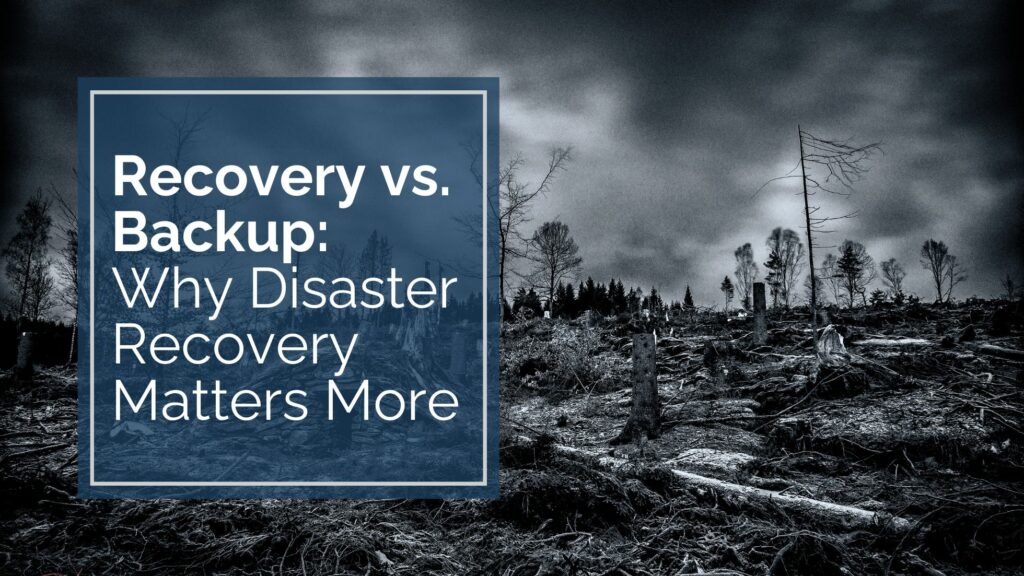The IT Safety Net That Too Many Businesses Don’t Have
Disaster recovery planning isn’t just about hurricanes or tornados. It’s about your business being able to keep going—when your office floods, when ransomware hits, or when someone accidentally wipes your accounting system.
Most businesses think they’re covered because they have backups. But recovery is about more than getting your files back. It’s about keeping your operations running. And too often, by the time business leaders realize that, it’s already too late.
Let’s talk about what disaster recovery services really do, what most growing businesses miss, and how to put the right safety net in place.

What Is Disaster Recovery, Really?
Disaster recovery (DR) is a business continuity strategy that allows your systems, data, and operations to be restored after a disruption—whether it’s a cyberattack, server failure, natural disaster, or employee mistake.
It goes beyond “data backup” by covering:
- How quickly systems can be brought back online
- Which apps or departments are restored first
- Where users will work if your primary systems are down
- What the communication plan is for customers or partners
Without a DR plan, recovery becomes a mad scramble—costing you time, money, and customer trust.
Why Do Businesses Get This Wrong?
Because they think backups = recovery. But backups are like taking a picture. Recovery is about putting the picture back in the frame, hanging it on the wall, and getting everyone back to work like nothing happened.
Here’s what we see most often:
- No recovery time expectations set (RTO/RPO unknown)
- No offsite redundancy for key systems
- Outdated documentation or disaster plans that no one follows
- Key apps like QuickBooks, EMRs, or file shares not prioritized for recovery
- No testing or simulation of how long recovery actually takes
The Business Cost of a Bad Recovery Plan
When disaster strikes, the impact isn’t just technical. It’s financial, operational, and reputational.
Here’s what goes wrong without a solid DR strategy:
- Lost billable hours or service revenue
- Downtime for patient care or client deliverables
- Reputational damage with partners or customers
- Compliance risks from data exposure or delays
- Overworked internal teams trying to DIY a recovery
How ProSafeIT Builds Disaster Recovery into Your Business—Not Just Your Backup
At Stringfellow, we bake disaster recovery into the way your IT operates every day. That includes:
- Cloud-first systems that don’t depend on your office
- Pre-tested recovery plans and prioritized service tiers
- Image-based backups with verified restore capabilities
- Clear roles, responsibilities, and timelines
- Annual DR tests to simulate the worst (so you can survive it)
The goal isn’t just to “have a plan.” It’s to be confident your business will still be running if something goes wrong.
Think You’re Covered? Let’s Find Out.
We’ve helped companies discover they were a single power outage or server failure away from a major business interruption. You don’t want to learn that during a crisis.
📍 [Let’s review your disaster recovery plan] — or build one that actually works.
Frequently Asked Questions about Disaster Recovery and Backup
What’s the difference between backup and disaster recovery?
A backup stores your data. Disaster recovery brings your systems, users, and operations back online after an incident.
How often should we test our disaster recovery plan?
At least once per year, or any time your infrastructure or processes change significantly.
Is disaster recovery expensive for small businesses?
No. With cloud-first tools and proactive planning, it’s more affordable than downtime or reputational damage.
What does a disaster recovery plan include?
Recovery time objectives, communication steps, system priorities, testing cadence, and responsible personnel.




